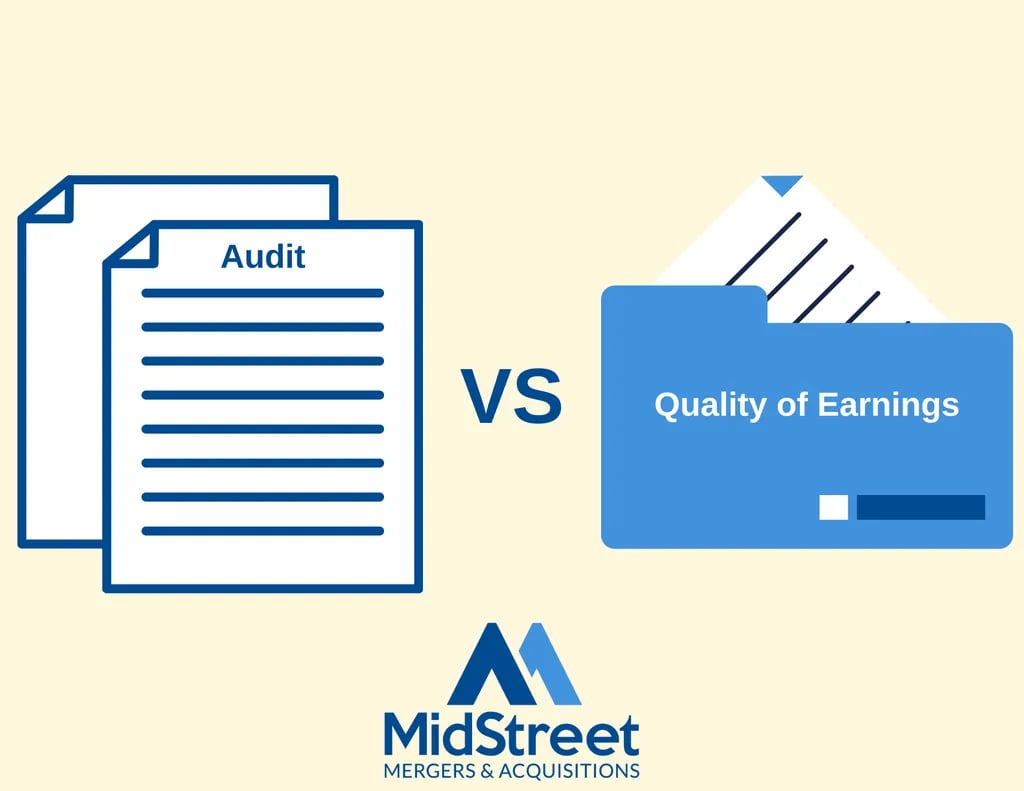What is a Quality of Earnings (QoE) Report?
If you’re in the process of selling a business that does more than $1 million in EBITDA, then you may have heard the term "quality of earnings report", or "QoE” floating around, especially as you approach due diligence.
You may be wondering what a quality of earnings consists of, what it means for the value of your business, and how it differs from an audit. In this blog, we’ll break down the purpose of a QoE, the difference between a QoE and an audit, and what documents you can expect to be requested while a QoE is being prepared.
Lets jump in!
Quality of Earnings Defined
A quality of earnings report is typically performed during the due diligence process and used to analyze your business's financials to better understand its historic earnings and the potential for future performance.
The report is often prepared by a third party, usually an accounting firm hired by the buyer.
Why is a quality of earnings report necessary?
In short, the buyer will be attempting to validate your business's financials.
Since your net income doesn't provide a complete indication of your business's financial performance, the buyer will need to determine a true adjusted EBITDA number.
This needs to be a number they have confidence in because it is the basis for their investment decisions.
To complete the report, the firm working on the QoE will review detailed data from your financials, bank statements, ledgers, customer information, and other transaction level data.
When the report is complete, the buyer will understand the amount of revenue your company produces, the accuracy of your business's financials, and the sources of your revenue.
This will help create a complete picture of the amount of revenue your business produces, the amount and accuracy of your business's financials, and the sources that make up your business's revenue.
Audit vs. Quality of Earnings
You may be saying to yourself, “but wait, shouldn’t an audit be enough to fact-check my business’s earnings?” Well, yes... and no.
While an audit does fact check a business’s financials, it isn’t nearly as detailed as a quality of earnings report, and is used for different purposes that are usually tax related. To give you a better understanding, let’s take a look at some of the differences between the two.
Audit
Simply put, an audit is used to provide reasonable assurance that a company’s financial statements are free from material misstatement. In essence, audits confirm that the reported earnings match the actual earnings in a given fiscal year.
Something else that an audit focuses on is verifying that a company’s financial statements conform to the relevant accounting standards (US GAAP). Essentially, this verifies that all of the accounting methods are legal and free of fraud.
Audits take into consideration other things too (like internal controls, account balances, and analytical procedures), but the main way that an audit differs from a QoE is in its purpose, which isn’t generally geared toward buyers or investors as an audience.
Quality of Earnings
A quality of earnings report, on the other hand, is much more detailed and is tailored to a buyer or investor's needs.
The purpose of a QoE is to learn about the quality and source of a business’s earnings. While a QoE is usually performed by a third party hired by a buyer, it’s also common for a business owner to have someone run a QoE on their business to have a more detailed understanding of their business’s earnings and help the sale of their business run smoother.
During a QoE, the accounting firm will try to figure out two main things:
- Is a business making as much money as the seller claims it is? (Amount)
- What are the primary sources responsible for the business’s earnings? (Source)
The first thing to determine is if the number used to represent a business’s earnings is accurate. Some companies use aggressive accounting methods that either inflate profits or creatively represent expenses in order to make their company look more attractive to buyers or investors.
It is the job of those performing a QoE to discover any of these aggressive accounting methods and analyze how much money is actually flowing in and out of a business.
The second thing to determine is the source of a business’s profits. This is where a QoE differs greatly from an audit, and where the really detailed accounting comes into play. To do this, the accounting firm will do a detailed dive into the individual products or services that generate a business’s profits to rule out a few possibilities.
One thing they are trying to rule out is if a high concentration of profit is tied to a non-recurring source, such as an unusually large job or sale that isn’t typical of that business.
They are also looking to make sure that there isn’t a high concentration of profit that is tied to only a handful of customers, which poses certain risks for future profitability if one of those customers is lost.
Some other things that a quality of earnings report may analyze are:
- Has the business lost any key customers?
- To what extent is the business driven by non cash sales, and what is the likelihood that those receivables will be collected?
- Profitability by division and location
- What is the seller’s adjusted EBITDA, and how does it compare to the EBITDA that had been reported by the seller?
Quality of Earnings can differ depending on a business’s size and industry, as well as what the buyer wants to take a closer look at.
This report isn’t just a way of fact checking financials and looking at numbers; it also helps a buyer gain an understanding of what risks may be involved in taking over a business.
Sell-side Quality of Earnings
Earlier in this blog, we mentioned most Quality of Earnings reports will be ordered and conducted by the buyer.
But if you're selling a company and want a leg-up in negotiations, you'd be wise to consider a sell-side Quality of Earnings report prior to listing your business for sale.
While there will be a cost to conduct this report, you can expense it through the company and consider it an add-back when calculating EBITDA.
The benefits of conducting a sell-side QoE can not be understated as a seller. Here are just a few of the main benefits:
- Fewer Issues: Any issues that can be solved prior to going to market are identified up front, not by the purchaser
- Faster Process: The timeline to sell your company speeds up significantly
- More Credibility: Due Diligence becomes more about confirming results, than uncovering issues
- Strong Defense: You have a report that accurately quantifies the earnings of your company, and a team of highly qualified accountants to defend its results
- Increased Leverage: Your preparedness will communicate a high level of professionalism and knowledge to the buyer, improving your negotiating position and driving up your multiple
- Offer Consistency: The Initial offers you receive will be much closer to your final payment for the company, because the offers were based on quality financial reports
- Working Capital: QoE reports also calculate the Net Working Capital (NWC) for the transaction
Sell-side Quality of Earnings Cost
The cost of a QoE report will depend on several factors including the size and complexity of the company, the speed at which the report is needed, and the level of detail required for the report. That said, the cost should fall somewhere between $25,000 and $60,000.
Don't forget - this is a business expense that can be added back for EBITDA, and should drive much more value than its initial cost.
Quality of Earnings Examples
To give you a better understanding, let’s take a look some examples of findings in a QoE.
Example 1
ABC Manufacturing is undergoing a QoE. Their financials are clean, and their accounting policies meet all the GAAP requirements, but there’s one problem: the business has an excessive concentration of revenue with one customer that contracts them for half of their jobs, making up 50% of their earnings.
With this information, the buyer now must consider if they are willing to take the risk of ownership over a manufacturing company that could lose half its profits if that customer decides not to renew their contract with ABC Manufacturing.
The earnings reported are accurate, but the quality of those earnings is now under scrutiny because of the increased risk that profits won’t remain consistent if one customer is lost.
Example 2
Main Street Construction does $10M in revenue. In an average year, they will be hired for 1,000 jobs, some repair and some installation, but the financials for both of these job types are combined.
The QoE report may break down the revenue and EBITDA shown on the Profit and Loss statement (P&L) into the amount earned on each job. When this is done, the Q of E reveals that repair jobs are far more profitable than installation jobs.
Similar to example one, the new owner now has to consider if they are willing to take over a business in which one type of job makes up the majority of earnings, with the risk of profits falling if suddenly the company sees a decrease in demand for that type of job.
There may also be significant equipment upkeep or licenses required to continue performing the less profitable jobs, which the new owner now has to consider as less rewarding expenses.
Documents Requested for a Quality of Earnings
The list of documents that will be requested during a QoE includes typical due diligence requests with things like tax returns, P&Ls, and balance sheets.
It also starts to include much more detailed reports about specific parts of a business. The following list contains examples of documents that we’ve seen requested, but it’s unlikely that a buyer will ask for all of them.
- A list of customers with revenue for each over the last year
- Copies of all key contracts to verify the terms
- Work-in-progress (WIP) schedule to determine the profitability of each individual project (if applicable)
- Balance sheets to determine the company's working capital needs
- General ledger or account ledgers for important accounts
- A copy of QuickBooks files or access to your ERP to pull reports
- Monthly financial statements for 3-5 years
- Detailed aging information on accounts payable
- Detailed employee information to confirm salary and benefits
Takeaways
In short, a quality of earnings report is a detailed analysis tailored to a buyer’s requests that analyzes both the amount and source of a business’s earnings. Its primary purpose is to check for anything that may indicate risk for the buyer, and better inform them of where a business’s profits come from.
A QoE differs from an audit in that it also analyzes quality instead of just accuracy and legality.
Many M&A Advisors and CPAs use the analogy of taking a car to a mechanic for a pre-purchase inspection before purchasing it to explain a QoE.
And finally, sellers can also benefit greatly from conducting a QoE during the sale of their business.
At MidStreet, we’ve seen several QoE reports done, and have a professional understanding of what they entail. If you still have questions, or would like to inquire about how MidStreet can make the QoE process easier on you, contact us today. We’d be glad to help!




